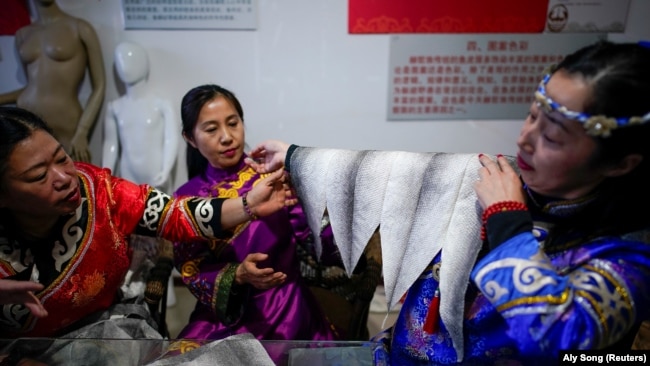The Hezhen are one of China’s smallest ethnic minority groups. Early Hezhen people developed methods for making clothes, bedding and thread out of fish skin. For that reason, they became known in China as the “Fish Skin Tribe.”
But today, the tradition is dying.
You Wenfeng is one of the few people in her community carrying on the tradition.
She was not yet born when her people were sent to labor camps during Japan’s occupation of Manchuria in the 1930s and 1940s.
You, who is 68, told Reuters reporters that many Hezhen died in the camps. But her mother survived, and she taught her daughter about fish skin.

Ethnic Hezhen You Wenfeng's Chinese Han students learn how to make clothes from fish skin at You's studio in Tongjiang, Heilongjiang province, China December 31, 2019.
The Hezhen are native to Siberia. Traditionally, they were hunters and fishers, making their living along rivers.
After World War II, the Hezhen population grew from 300 to 5,000 along the Amur River, also known as the Black Dragon River.
But that population growth did not stop the loss of Hezhen culture, including making clothing from the skin of fish like carp, pike and salmon.
Few young Hezhen wanted to learn the skill. Fish-skin clothing is also not what Hezhen people wear today.
Knowing this, You started to share her knowledge with local Han Chinese women in Tongjiang, where she lives. The quiet city sits near China’s northeastern border with Russia.
You’s followers also learn the Yimakan, a kind of storytelling that uses both speech and song in the Hezhen language.

The lessons are not easy. You’s followers memorize songs of fishing, hunting and ancient tribal victories in a language they do not speak.
During a visit by Reuters reporters, You began to sing in her small apartment. She sang of a woman’s wish to have a son for her hunter-husband.
Hezhen hunters rode on narrow boats made from birch wood. You described the boats as “swift horses.” The Hezhen were so skillful on water that their ancient stories say they came from mermaids.
“When the forests flooded to the treetops, there would be fish everywhere,” You said.
These days, fish are bought from the marketplace. And instead of tiger bone and the tissue of deer, a special sewing tool and cotton thread are used.
A piece of clothing for a woman requires 50 fish. For a man, it requires 56, You said.
The first step is to remove the fish’s skin and dry it. The skin is then repeatedly passed through wooden “teeth” to soften it. The process takes a month. Sewing then requires about 20 more days.
Fish leather has inspired some high-end clothing design houses, including Dior and Prada, to use it in their clothes. But the material is still not common.
You says fish skins are “stronger than most skins.”
In 2006, Hezhen fish skin clothing was listed by China as intangible cultural heritage, which means a special effort is made to preserve the tradition.
I’m Alice Bryant.
Reuters news agency reported this story. Alice Bryant adapted it for Learning English with additional information. Ashley Thompson was the editor.
Words in This Story
swift – adj. moving or able to move very fast
mermaid – n. an imaginary sea creature that has a woman's head and body and a fish's tail instead of legs
sewing – gerund. the making or repair of something by using a needle and thread
leather – n. animal skin that is chemically treated to preserve it and that is used in making clothes, shoes, or furniture
intangible – adj. not made of physical substance